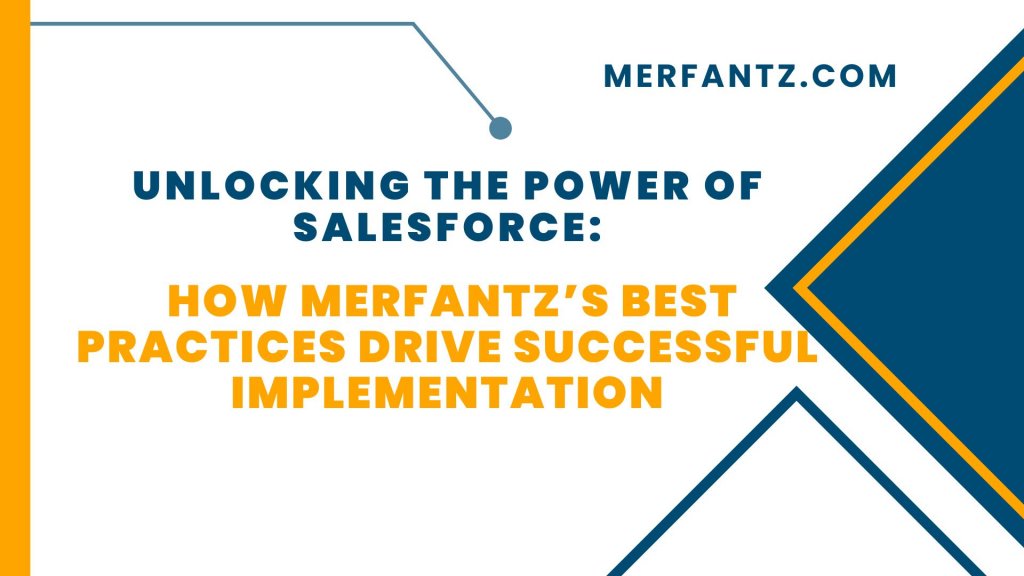Salesforce is a powerful CRM tool that can help your business manage customer relationships effectively. However, to achieve a successful implementation, you need to follow specific steps and best practices. In this article, we will provide you with a comprehensive guide to Salesforce implementation.
What is Salesforce Implementation?
Salesforce implementation refers to the process of setting up and configuring Salesforce to meet your business requirements. The implementation process includes defining your business objectives, choosing the right Salesforce edition, selecting the right implementation partner, planning your implementation, customizing Salesforce to meet your business needs, testing your implementation, training your users, and going live with Salesforce.
Why is Salesforce Implementation Important?
Salesforce implementation is essential because it can help your business streamline its processes, improve customer relationships, increase sales, and drive revenue growth. Additionally, a successful Salesforce implementation can provide your business with valuable insights into customer behavior, preferences, and needs.
Step-by-Step Guide to Salesforce Implementation
Step 1: Define Your Objectives
The first step in Salesforce implementation is to define your business objectives clearly. You need to decide which Salesforce features you need to implement to achieve your goals. For example, if you want to improve customer relationships, you might want to implement Salesforce Service Cloud. Similarly, if you want to increase sales, you might want to implement Salesforce Sales Cloud.
Step 2: Choose the Right Salesforce Edition
Salesforce offers different editions that cater to businesses of various sizes and requirements. You need to choose the right edition that suits your business needs. The most common Salesforce editions are Enterprise, Professional, and Unlimited. Each edition comes with its set of features, limitations, and pricing.
Step 3: Select the Right Implementation Partner
Choosing the right implementation partner is crucial for a successful Salesforce implementation. You need to partner with a company that has a proven track record of successful Salesforce implementations, understands your business requirements, and can deliver within your budget.
Step 4: Plan Your Implementation
After selecting your implementation partner, you need to plan your implementation thoroughly. You need to define your project scope, budget, and timeline. Additionally, you need to consider data migration, system integration, and user training.
Step 5: Customize Salesforce to Meet Your Business Requirements
Salesforce is a highly customizable platform that can cater to various business requirements. You need to customize Salesforce to meet your business needs. This customization can include creating custom fields, workflows, validation rules, and reports.
Step 6: Test Your Implementation
Before going live with Salesforce, you need to test your implementation thoroughly. You need to ensure that all the customizations work as intended and all data is migrated correctly.
Step 7: Train Your Users
Salesforce is only effective if your users know how to use it correctly. Therefore, you need to train your users to ensure they can use Salesforce efficiently. You can provide online training, on-site training, or a combination of both.
Step 8: Go Live with Salesforce
After completing all the above steps, you are ready to go live with Salesforce. You need to communicate the changes to your employees and ensure they are comfortable with the new system.
Best Practices for Salesforce Implementation
In addition to the steps outlined above, there are specific best practices that you should follow to ensure a successful Salesforce implementation.
1. Involve Your End Users
It’s essential to involve your end-users in the Salesforce implementation process. Your users know your business processes, pain points, and requirements. Therefore, involving them can help you customize Salesforce to meet your business needs better. Additionally, involving your users can increase user adoption and satisfaction.
2. Keep Your Data Clean
Data is the lifeblood of Salesforce. Therefore, you need to keep your data clean and organized. You need to define data ownership, establish data governance policies, and maintain data quality. Additionally, you need to ensure that your data is secure and compliant with data privacy laws.
3. Plan for Integration
Salesforce is a part of your larger IT ecosystem. Therefore, you need to plan for integration with other systems such as ERP, marketing automation, and billing systems. Integrating Salesforce with other systems can help you streamline your processes and improve data accuracy.
4. Focus on User Adoption
User adoption is critical for the success of your Salesforce implementation. Therefore, you need to focus on user adoption from the start of the implementation process. You can involve your users in the design phase, provide them with adequate training, and provide ongoing support. Additionally, you can incentivize users who adopt Salesforce quickly and effectively.
5. Monitor and Measure Success
Finally, you need to monitor and measure the success of your Salesforce implementation. You need to define key performance indicators (KPIs) such as user adoption, data quality, and revenue growth. Additionally, you need to track these KPIs regularly and make adjustments to your implementation as necessary.
How Merfantz’s Best Practices Drive Successful Implementation
Merfantz is a leading Salesforce consulting and implementation partner that prides itself on following best practices to ensure successful project delivery. The company’s delivery model is designed to provide a structured approach to Salesforce implementation, with a focus on meeting the needs of clients and ensuring that their objectives are achieved.
At the heart of Merfantz’s delivery model is a commitment to understanding the unique needs of each client. This involves a detailed analysis of the client’s business processes and requirements, as well as an assessment of the existing technology landscape. Based on this analysis, Merfantz develops a customized implementation plan that is tailored to the specific needs of the client.
One key element of Merfantz’s delivery model is a focus on user adoption. The company recognizes that successful Salesforce implementation depends on the active participation of users, and therefore places a strong emphasis on user training and support. This includes providing comprehensive training on Salesforce functionality and best practices, as well as ongoing support to ensure that users are able to effectively utilize the system.
Another important aspect of Merfantz’s delivery model is a commitment to continuous improvement. The company recognizes that Salesforce is a dynamic platform that is constantly evolving, and therefore places a strong emphasis on staying up-to-date with the latest developments and best practices. This involves ongoing training and certification for the company’s consultants, as well as a focus on continuous improvement of the implementation process.
Merfantz’s delivery model provides a structured and customized approach to Salesforce implementation that is focused on meeting the unique needs of each client. By following best practices and emphasizing user adoption and continuous improvement, the company is able to deliver successful projects that help clients achieve their objectives.
FAQ Section:
Q: How do you implement Salesforce successfully?
A: Successful Salesforce implementation requires careful planning and execution. It is important to define your objectives, assess your existing technology landscape, and develop a customized implementation plan that is tailored to your specific needs. In addition, user adoption is critical to success, and therefore it is important to provide comprehensive training and ongoing support to ensure that users are able to effectively utilize the system.
Q: What are the phases of Salesforce implementation?
A: Salesforce implementation typically involves several phases, including planning, design, development, testing, and deployment. During the planning phase, the objectives of the implementation are defined, and the existing technology landscape is assessed. The design phase involves the development of a detailed implementation plan, and the development phase involves the customization of Salesforce to meet the specific needs of the client. Testing ensures that the system is functioning correctly, and deployment involves the rollout of the system to users.
Q: What are the three critical success factors for new implementation in Salesforce?
A: Three critical success factors for new implementation in Salesforce are defining clear objectives, having a structured implementation plan, and ensuring user adoption. It is important to have a clear understanding of what the implementation should achieve and develop a plan that is tailored to the specific needs of the client. User adoption is critical to success, and therefore it is important to provide comprehensive training and ongoing support to ensure that users are able to effectively utilize the system.
Q: Which are the four pillars of Salesforce success?
A: The four pillars of Salesforce success are strategy, people, process, and technology. A successful Salesforce implementation requires a clear strategy that is aligned with the objectives of the business. In addition, it is important to have the right people with the necessary skills and experience to lead the implementation. A structured process is critical to success, and the right technology tools and platforms are needed to support the implementation.
Q: How does Merfantz ensure successful Salesforce implementation?
A: Merfantz ensures successful Salesforce implementation by following best practices and its well-defined delivery model. This involves a detailed analysis of the client’s business processes and requirements, as well as an assessment of the existing technology landscape. Based on this analysis, Merfantz develops a customized implementation plan that is tailored to the specific needs of the client. The company also places a strong emphasis on user adoption, providing comprehensive training and ongoing support to ensure that users are able to effectively utilize the system. In addition, Merfantz is committed to continuous improvement, staying up to date with the latest developments and best practices in Salesforce.
Conclusion
Salesforce implementation can be a complex and challenging process. However, by following the steps and best practices outlined in this article, you can achieve a successful implementation that can help your business streamline its processes, improve customer relationships, and drive revenue growth. Remember to involve your end-users, keep your data clean, plan for integration, focus on user adoption, and monitor and measure success. By doing so, you can ensure that your Salesforce implementation is a success.
Author Bio
Co-Founder & CMO at Merfantz Technologies Pvt Ltd | Marketing Manager for FieldAx Field Service Software | Salesforce All-Star Ranger and Community Contributor | Salesforce Content Creation for Knowledge Sharing






